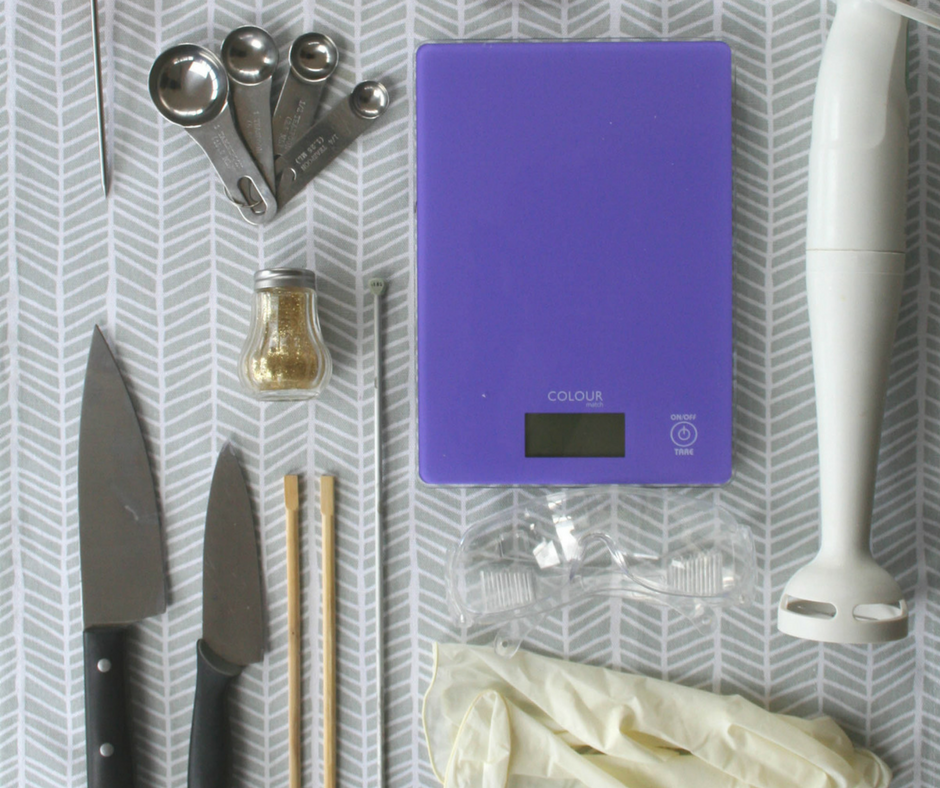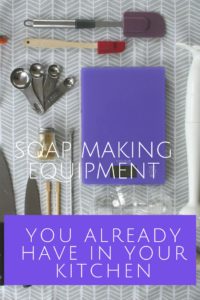Soap Making is one of the most cost-effective hobbies to start because it doesn’t require much specialised equipment to get started. Many things you’ll need can be found in your own kitchen. Leave the expensive stuff until you find out if you love soap making (I think you will!)
Weighing – Scales are a necessary piece of kit. It’s not possible to use measuring equipment instead because all the ingredients for soap making are measured by weight. This is due to the need for accuracy. I would recommend spending some money on them if you don’t have a set already. They are not expensive and can be bought online or in your local electronics store.
Chopping – You’ll need to do this to break up any oils such as palm or coconut oils which generally come in large blocks. A suitably sized knife is perfect for this. Soap additives such as petals, leaves and herbs may also need to be chopped up before adding.
Melting – Your hard oils will need to be melted before you can use them. You can put them in a stainless steel pot on the stove or you can use a microwave (obviously use a plastic bowl in the microwave). You’ll need to let them cool a bit before they will be at the correct temperature.
Measuring temperature – It’s really handy to have a thermometer as a new soap maker. You can easily make sure the temperature of your oils and lye mixture is within the recommended range before you start. All soap makers have their own preferred temperature at which to soap. I prefer just above room temperature so I don’t really use a thermometer much anymore. But it is useful to have one until you find your own preferences. You can get them in any kitchen store or online if you don’t already have one.
Stirring and scraping – Spatulas are perfect for this! I love to get every last drop out of my soaping bowl. Plastic is best as wooden spoons tend to react with the lye as does aluminium. You can use stainless steel spoons as they don’t react but they are not as good at scraping.
Bowls and jugs – Anything big enough to fit your soap recipe is perfect. Again plastic is best but you can use a ceramic bowl too. Stainless steel pots can also work but make sure your pots are not made from aluminium or they will react with the lye present. Make sure the jug you use for the lye mixture can resist a fair amount of heat. Mixing the lye with water is an exothermic reaction, so using glass is not the best plan. Heat resistant plastic is best but many soap makers use metal jugs. You will need smaller jugs for mixing the colour into portions of your batter. Small bowls are very useful for mixing powdered colour with water or oils
Mixing – You can mix by hand in which case all you will need is a long-handled spoon or a whisk to stir…but this can take a very long time. Most soap makers use an immersion (or stick) blender. This allows very fast mixing without the addition of bubbles to the mixture. Electric mixers…the type with beaters, are not the best as they add too much air to your soap mixture causing air bubbles in the finished soap.
Moulding – just about anything can be used for a mould if it is lined. My first soap was moulded in a plastic lunchbox. Or you can use an empty milk carton (washed first of course), a Pringles carton or a yoghurt pot. Silicon cooking moulds are very convenient as they don’t need to be lined and are easily removed from the soap. The variety of moulds you can buy once you are ready is quite staggering.
Swirling and patterning – Once you have made your new batch of soap you might want to swirl the colours together. Chopsticks are perfect for this, small spoons are great, a wire clothes hanger can be bent into a swirling implement, almost anything you can think of that will move the soap around can be used. Patterns can be made on top of the soap to give it texture. You can be as creative as you like.
Insulation – If you choose to insulate your soap you will need a few old towels or blankets to wrap around it. You may also want a piece of old cardboard to cover your soap if your mould doesn’t have a lid.
Table protection – Soap mixture is very likely to damage your table surface as it is very caustic to begin with. You can use a paper tablecloth, an old piece of fabric, newspaper, a layer of cardboard or anything similar to protect your table.
There are so many things that you can use you’ll find yourself looking around thinking ‘Can I soap with this’!
So now that you are all set up you are ready to visit the article on Working With Lye.


